
Sunday, 6 June 2010
Distance 32 km
Duration 6 hours 10 minutes
Ascent 543 m, descent 437 m
Map 41 of the TOP100 blue series (or Map 147 and 146 in the new lime-green series)
Topoguide (ref. 6542) Sentier vers Saint-Jacques-de-Compostelle via Vézelay
In the morning it was cooler and clouds were building up as we left the hotel at 7:30. Our first destination was the cathedral, where we knew we would pick up the pilgrim signs to guide us out of town. We were still limping, but after a while the pain faded.
In the cathedral square, just in front of the door to the gîte, we were amazed to see our pilgrim friend with the wheeled cart, and we asked him whether he had slept in the gîte last night. No, he said, he had dossed down in the industrial area on the outskirts, the one we had walked through yesterday. Apparently he had walked 38 km that day and had been too exhausted to go on. Now he was hungry and went off to find some breakfast.

We looked down the lane leading to the pilgrim footbridge, but did not descend, not wanting to irritate our feet any more than necessary.
Soon we were swinging along through the centre of Limoges, quiet at this hour on a Sunday, following the blue and yellow signs in a generally south-westerly direction.
We had no trouble until we got to the Rue Pierre et Marie Curie, where the signs vanished. The only ones we could find pointed back towards the centre and we came to the conclusion that someone had removed and relocated them for a lark.

Luckily for us, the inhabitants of this unprepossessing town seemed to be unusually helpful, or perhaps we were looking unusually lost. Without our having to ask, we were directed downhill by a jogging man, then up the other side by two old ladies out for a walk, and finally, at Isle, out into the countryside by a couple with a dog.
All this way through the built-up area, we saw not one bar, and our breakfast of muesli was no longer sustaining us.
It began to rain, so we got into our capes and trudged on, along a small road through the fields. At least we were on the pilgrimage again – the markers had reappeared as we left the houses.

At Merignac we asked a man who was tending his garden, whether there was a bar in the village and the poor fellow looked most apologetic as he admitted there was nothing until Aixe.
However it was only a few more kilometres until we struck the river and the highway, from where we could see the beginnings of the town of Aixe-sur-Vienne. There were great roadworks taking place but we got round them on a temporary boardwalk and hurried into the streets.
There were shops, all closed, and we could not see a bar, so we asked a man who was walking past. He said that the nearest bar was a kilometre and a half away, over the bridge and up the hill.
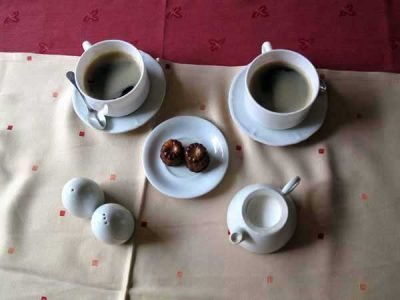
This was surprising, as the population of Aixe-sur-Vienne was supposed to be 5000, and deeply depressing for people with feet as sore as ours. Then we noticed an auberge on the corner near the bridge, and went in without much hope to ask about coffee.
The man courteously waved us into a sort of sitting room, not into the main room which was set up for dining. We got the feeling that it was their own private sitting room and that they did not normally operate as a bar, but were doing it out of sympathy for us.

Coffee arrived on a tray, accompanied by little cakes, and it was so reviving and delicious that we had a second round. As we left I told the man that he had saved our lives, which seemed to amuse him.
Crossing the bridge, we found that our informant had been totally wrong.
The main part of town was on the other side of the river and there were several open bars there. Nevertheless we were glad we had gone to the auberge.
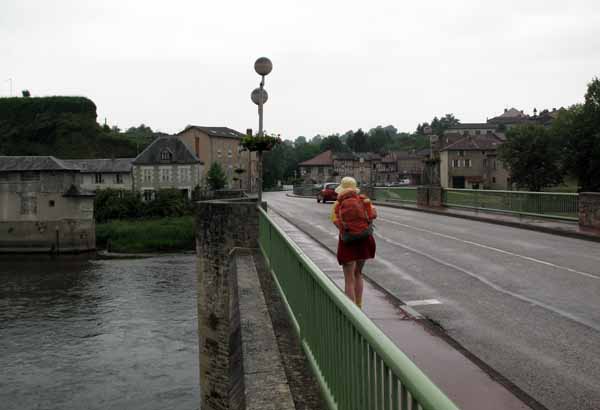
We charged up the highway but quickly realised that we had lost the pilgrim markers and had to double back. We were constantly at a disadvantage through not having much of an idea which way the pilgrim route was going.
Having found the markers again, we set off on a tiny road that wove its way in picturesque fashion through hills and hollows, meadows and copses, all shining green after the rain.
Periodically there was a roll of thunder and another flurry of rain. I had the map underneath my plastic poncho, which made it hard to read, but there was no chance of getting lost with the pilgrim markers.
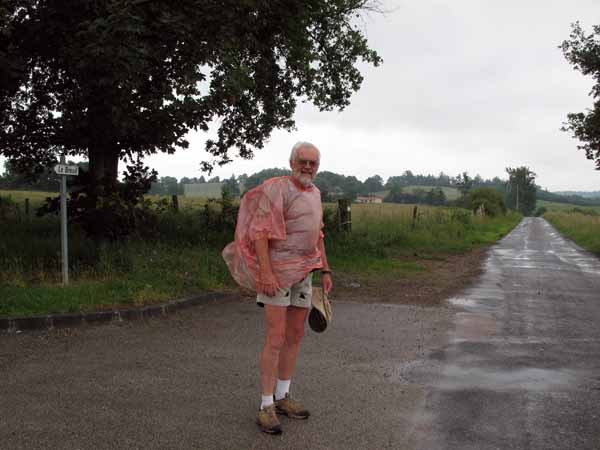
We felt that we were nearing Flavignac, our destination, and indeed a church spire and some rooftops came into view.
At a bend in the road there was a sign, “St-Martin-le-Vieux, 1 km”, meaning that we were actually only halfway to Flavignac, after all that weaving about.
Disgusted and incredulous, we trudged into the village, which was pretty enough, with a handsome church at the intersection of five ways.
It had a bell-wall and a fine flight of steps, but no shelter from the rain, which had now resumed in earnest. The only dry place we could find for our lunch was a bus stop.

Having not seen a single human being, we left Saint-Martin-le-Vieux, but not on the pilgrim way. We had had enough of tortuous country lanes, and marched up to the D20, which took us straight to Flavignac in short order.
In the centre of the village was a wide square flanked by shops, but naturally they were all closed, even the bar. However there was a notice on the bar door saying that it would open at 5 pm.
There was supposed to be a camping ground at Flavignac, but the prospect of huddling in our tent in the rain did not appeal, especially as the village restaurant was closed on Sundays.
Opposite the church we saw the gîte symbol on the door of a cottage, and when we knocked, the adjacent door opened, revealing a young woman who was the guardian of the place. We paid €10 each for a bed, and she stamped our Topoguide, as I assured her that créanciales did not exist in Australia.

It was a tiny gîte with only four beds, and we were the first walkers to arrive. A moment later, two others plodded up from the downhill direction. They had come from Solignac, having skirted Limoges altogether. One was a Dutchman and the other a Belgian from the Flemish sector, so they had a language in common. The Dutchman, Kees, was also handy in English.
Later another person arrived, a German girl called Maria, who had almost no money and had arranged with the guardian that she would sleep in her tent outside without having to pay, but use the showers and the cooking stove.
There is always plenty to talk about in a group of walkers – maps, routes, plans, previous adventures – and the conversation flowed merrily.
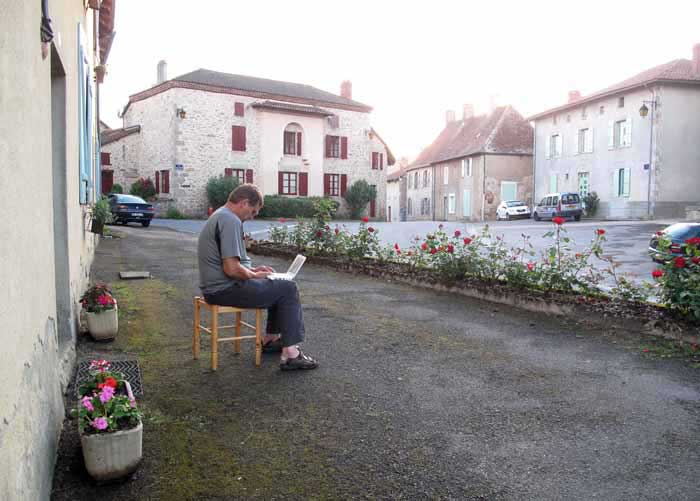
Kees occupied himself by ripping out the pages of the Topoguide that he no longer needed. Like us, he was a fanatic about travelling light. When he got to Spain, he said, he would cut off the legs of his long trousers and walk in shorts.
He was a rat-catcher by trade, employed by the Dutch government to kill the large American rats that burrowed into the dykes and caused them to leak. As we were to discover later, he was a wonderful walker and a natural philosopher.
Peter the Belgian was a big fellow with a gigantic load, but he was not a walker by inclination. He was doing the pilgrimage for reasons of faith, and was festooned with crosses and cockle shells. To our amazement, he pulled out a laptop from his pack and began writing his daily blog.
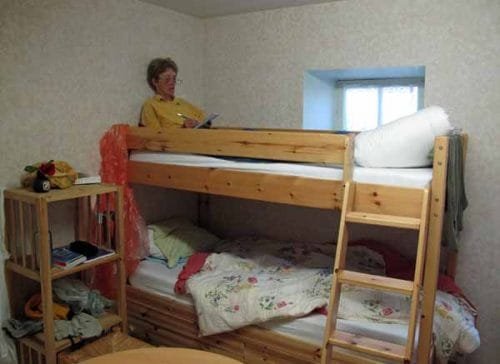
Meanwhile Maria had retired to her tent to practise Spanish for the second half of the pilgrimage. I thought she would do better to work on her French, which seemed to be non-existent. She said that she had sold all her possessions, including her furniture, in order to make this pilgrimage.
At 5 o’clock we went down to the bar and found it open as promised. We had pastis and rosé, while our low-country companions had beer. They complained to the barman that the beer was much better where they came from, but he pointed out that it was Belgian beer that they were drinking, not French.
On the way back to the gîte we went into the lovely old church and admired its graceful vaulting and the great paving stones, worn to a polish by centuries of feet.

None of us had much food about us, but we found a packet of macaroni in the cupboard and a limp old onion in the fridge. Keith and I contributed the remains of our sausage and a tomato, Kees and Peter put in some cheese, and Maria added a tin of tuna.
We combined all this in a saucepan and It was ghastly but we ate it. Then we had coffee and chocolate.
During the night I suffered a terribly upset stomach but did not dare to climb down from my bunk for fear of disturbing the others, so I lay awake miserably until dawn.
Previous day: St-Léonard-de-Noblat to Limoges